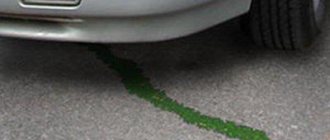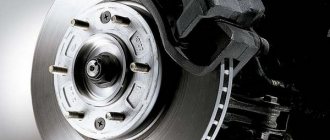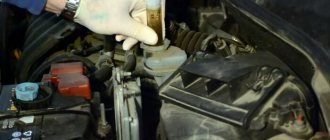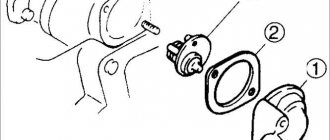Typical problems
Some novice motorists believe that horror stories associated with untimely replacement of antifreeze in the car are a marketing ploy by manufacturers. Yes, if you fill in the refrigerant with a slight delay, the risks of catching a wedge will be minimal. But there are other very real problems that many are not aware of. We have identified characteristic negative factors that appear when antifreeze is not replaced in a timely manner.
1. Overheating, interfering with the normal operation of the internal combustion engine
Normal engine operating temperature ranges from 85–90 °C. It is for this range that the clearances and materials of the power unit are designed. Overheating leads to a drop in power while simultaneously increasing fuel consumption. Insufficient cooling deforms the rings and cylinders. Increasing the gaps leads to exhaust gases entering the oil or grease into the exhaust manifold. If an internal combustion engine regularly operates above the standard temperature range, its service life is reduced by approximately 2–3 times.
2. Corrosive effects
The coolant contains a small amount of water (up to 5%). But antifreeze itself is highly hygroscopic. This means that even through contact with air it is able to absorb moisture. Consequently, over time, the refrigerant (namely the water in its composition) begins to provoke oxidative processes. Corrosion not only destroys the surfaces of the line and radiator. It reduces channel capacity and increases resistance. The corrosion layer has a lower thermal conductivity, which impairs the efficiency of the cooling system. All this creates extra load on the engine and heat-removing equipment.
3. Precipitation
This problem is typical for silicate-based antifreezes. Over time, some substances from their composition precipitate in the form of tiny silicon particles. As liquid circulates, the movement of solid components creates a significant abrasive effect.
4. Cavitation erosion
Cavitation refers to the natural process of formation of gas bubbles in a heated liquid. When these cavities collapse, significant energy is released, creating excess pressure in the vehicle's cooling system. In addition, bursting bubbles destroy metal surfaces, which leads to leaks. The new antifreeze contains special additives that minimize cavitation processes. But over time, the properties of the additives are lost.
5. System freezing
The high hygroscopicity of antifreeze leads to a constant increase in the concentration of water in the composition. This gradually lowers the coolant freezing threshold. If the water in the system crystallizes, then the tank, line elements, radiator and pipes suffer from expansion.
Now there should definitely be no doubt that it is necessary to regularly monitor the quality and condition of the coolant.
You may be interested in: How often do you need to add antifreeze?
Precautionary measures
Do not pour liquid into a cooling system with holes. Before filling, you need to check the reliability of the system and rinse it with clean water.
Do not fill the tank to the top - antifreeze can occupy no more than 90% of the total volume.
Do not allow oil, diesel fuel and gasoline to get into the coolant.
The main storage condition is clean containers without foreign inclusions.
Low-freezing fluids prevent damage to parts due to less expansion. When freezing, ordinary water expands in volume by 9%, while a mixture with dihydric alcohol can expand three times less. Antifreeze protects the engine system from overheating and freezing.
How often to change antifreeze in a car
| Group | Replacement period | Mileage |
| G11, Antifreeze | 2 years | 90 thousand km |
| G12, G12+, G12++ | 5 years | 150 thousand km |
| Multifreeze | up to 10 years | 250 thousand km |
This is a question many motorists ask themselves. But there is no universal correct answer for all cases. Experienced experts do not even advise relying entirely on the recommendations of the car manufacturer. The regulations indicate average recommendations that do not take into account operating conditions and quality of service. For example, there are years when in summer the air temperature during the day stays above 40 °C for a long time. If during such periods the car is actively used, then the antifreeze quickly loses its qualities. The condition of the cooling system lines at the time of filling the refrigerant is also important.
How often to change antifreeze in a car.
This depends on the make of the car, since different car manufacturers have their own recommendations on this matter.
| Car make | Antifreeze replacement frequency | Peculiarities |
| BMW | every 4 years | |
| Ford | once every 10 years | |
| G.M. | no need to change at all | |
| Hyundai | 10 years after purchase or if the mileage has reached 240,000 km | after 10 years, changes every 2 years |
| Kia | every 8 years | |
| Mazda | no need to change at all | not required during the entire life of the machine |
| Mercedes | every 5 years | |
| Mitsubishi | every 4 years | |
| Nissan | after 5 years | after 5 years changes every 3 years |
| Renault | in 6 years | relevant only for Reno Logan, Duster and Sandero; in many models replacement is not required at all |
| Skoda | after 6 years of operation | |
| Toyota | after 8 years of operation | after 8 years, changes every 4 years |
| Volkswagen | no need to change at all | It is recommended to change the fluid every 5 years, although the manufacturer says this is not necessary |
| AvtoVAZ | every 5 years | every 5 years for new models, and every two years for old ones |
Whether the coolant needs to be replaced and how often to change the antifreeze depends not only on the make of the car, but also on its mileage and the type of composition used. Approximate framework for how many kilometers it is necessary to fill in new coolant
Antifreeze and products of category G11.
These are traditional antifreezes with an inorganic composition. They usually contain a large amount of additives and are suitable for older car models or engines made of aluminum, cast iron and aluminum alloys. At what mileage should I change them? Approximately every 50–60,000 km. For new AvtoVAZ models, this figure can be up to 75,000 km.
Antifreeze class G12.
These are carboxylate compounds with organic additives. Their base is ethylene glycol, but the additives contain carboxylic acid. Such substances should be replaced every 120,000 km.
Hybrid formulations.
These may include antifreezes of the G12 category with varying numbers of advantages. They mix organic and inorganic substances, which is why such products are a hybrid. They are more effective compared to traditional or carboxylate formulations, as they combine their best qualities. The replacement period can range from 90 to 120,000 km.
Lobrid compositions.
Most often they are labeled as G13 class antifreezes, since they have a fundamental difference from the rest in their composition. The basis of such coolants is propylene glycol. They are safer for the car system, so they are also called low hybrid. Some of the antifreezes in the G12++ category are also classified as lobrid. They can be changed not very often: every 250,000 km.
Additional terms and conditions.
There are other factors that affect the timing of coolant replacement.
- The level of wear of the cooling system: the older it is, and the more corrosion or plaque on the pipes, the more often it is worth changing the antifreeze. If you see particles of rust in the refrigerant itself after draining, you should fill in a new one more often by 30%.
- Conditions of vehicle use: under increased loads or high temperatures, the quality of antifreeze in the system decreases. Therefore, after a hot season or operating the machine under high voltage conditions, it is worth checking the coolant.
- Unscheduled topping up: if you want to use a compound of a different class or type, regardless of the mileage, you should drain the old one.
Recommendations for replacing antifreeze
Having figured out how long it takes to change the antifreeze in a car, novice car enthusiasts usually have the question of how to cope with the task on their own without involving third-party services and technicians, whose services are expensive. In fact, coping with the task is not at all difficult if you know the procedure for completing it:
- The car is placed on a horizontal platform and allowed to cool properly after work, otherwise you can easily get burned, since the temperature of the technical fluid in the radiator, expansion tank, engine block and other elements can reach 90-96 degrees Celsius.
- Open the drain hole or disconnect the lowest pipe from the radiator if the car design does not provide a separate antifreeze drain point (most often relevant for domestically produced cars).
- It is strongly recommended to drain the antifreeze completely, especially if the owner plans to fill in a different class of refrigerant. To do this, you need to close the expansion tank, leaving the drain or pipe open, turn on the stove at full power and start the engine.
- After several minutes of operation, the engine is turned off, since longer operation without technical fluid in the system is fraught with overheating and deformation of individual elements.
- If antifreeze continues to drip from the drain hole, the procedure must be repeated after some time in order to create additional pressure to expel it from the system.
- The entire system is washed with distilled water, which will help remove the remaining old refrigerant (relevant when switching to a new coolant class).
- The drain or pipe is closed. Open the cap of the expansion tank and fill it with new antifreeze to the maximum mark.
- Turn on the stove, start the engine and give the car some time for all its systems to fill with antifreeze, after which they check its level in the tank, which must be filled to the maximum.
- The procedure is repeated as many times as necessary until antifreeze stops leaving the tank.
- After a few days of intensive use, a control check of the antifreeze in the tank is carried out and, if necessary, the required volume is refilled.
And if you follow the above instructions, the car will serve its owner faithfully for many years.
When to change antifreeze
In this matter, in any case, you have to focus on the mileage and date of the last coolant update.
it is important! Under normal conditions and provided that high-quality antifreeze is used, the need for replacement occurs every 90–150,000 km. But some motorists drive that many kilometers over several years. In such a situation, the antifreeze replacement interval will change. For short mileage, you need to focus on the terms specified by the coolant manufacturer, since it is he who determines how long the composition will retain its qualities. Depending on the production technology, automotive refrigerant can be used for 2–5 years.
Antifreeze manufacturer's recommendations
Each country involved in the automotive industry produces coolants based on its own accepted standards. Only such antifreeze is also exported. That’s why there is such a rich assortment of cooling system fluids on the shelves of car dealerships, of different brands, with their own characteristics and service life.
In order to somehow streamline the current situation, antifreeze manufacturers themselves began to use for their products the classification used by the Volkswagen concern, which divided liquids into three classes with their own recommended replacement periods: G11, G12, G13.
How to properly replace antifreeze
First you need to familiarize yourself with the technical documentation of the car. It always indicates the preferred timing for replacing process fluids, as well as important nuances of the process itself. In most cases, the service procedure follows the following algorithm.
Selection and purchase of suitable coolant. If a concentrate was chosen, then you need to find a container for diluting the composition with water, as well as measuring containers.
The car is installed on a level surface. All subsequent manipulations can be started after the engine has completely cooled down. This will require at least 30 minutes after stopping the engine. At this time, remove the keys from the ignition.
A tray or other suitable container is installed under the radiator to collect waste refrigerant. Next, the drain cap is unscrewed. Now you need to pour out the remaining coolant from the expansion tank. A flexible hose may be needed for this.
If the fluid has not been changed for a long time, then it is better to flush the cooling system using special compounds that are sold at any car store.
After this, new antifreeze is poured. How much to pour? It is better to focus on the mark in the expansion tank. After replacing the antifreeze, you need to pay attention to the temperature sensor indicator for some time. If everything went well, then he will not go beyond the green zone.
What is antifreeze and what is it for?
Antifreeze refers to a group of coolants that prevent the engine from overheating and freezing. It was invented in the 20s of the last century and began to be used to ensure optimal temperature for the engine. Before its appearance, an air cooling system was used to cool the engine, and after that, ordinary water was used.
Operating the car was difficult and unprofitable. To start the engine in cold weather, it was necessary to constantly drain water to replace the coolant. The longer water was used to cool the engine, the more breakdowns awaited the driver. And all because ordinary water contains many impurities and leads to corrosion of all metal elements of the system.
To facilitate operation and extend the service life of spare parts, they began to use a mixture of dihydric alcohol, water and additives. All coolants differ in the content of their components.
The antifreeze solution may consist of ethylene glycol or propylene glycol. The maximum temperature at which coolant freezes depends on the amount of water. The higher the ratio of water to ethylene glycol, the lower the threshold temperature.
For example, antifreeze containing 25% water and 75% dihydric alcohol freezes at -75°C, while an analogue with 35% water crystallizes at -65°C, and with 50% content - at -40°C.
Why do you need to change the coolant?
It is no secret that 40% of the cost of antifreeze is the cost of the additives in it, so over time they lose their properties, and ethylene glycol and water, which antifreeze mainly consists of, begin to corrode. Used antifreeze can easily cause irreparable damage to the cylinder head. Most often it is made of aluminum and is more susceptible to corrosion. It is enough to drive on bad antifreeze and the result will not take long to arrive.
Why change antifreeze? Damaged cylinder head
Additives that have lost their properties no longer lubricate the pump, and corrosion products (rust particles) can cause the thermostat to jam, which will inevitably lead to engine overheating and even more serious consequences.
There are many such malfunctions, or rather, they are all the result of used coolant. All these consequences can undoubtedly be avoided by timely replacement of the coolant.
Why change antifreeze? Spent antifreeze corrodes aluminum
The reason why antifreeze loses its properties is not only time, but also its operating temperature. In modern engines, the operating temperature exceeds 105°C, despite the fact that the fan operating temperature is about 115°C, and coolant circulates at the cylinder walls at a temperature of more than 125°C. Imagine the condition of the coolant that has been in the car for more than 100 thousand km. Of course, there are antifreezes that the manufacturer fills in for the entire service life of the car, but now we are talking about average cars that most often require coolant replacement.











